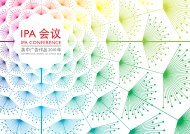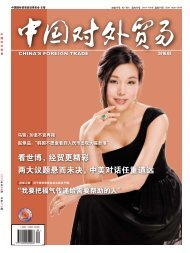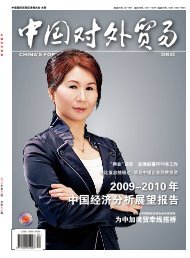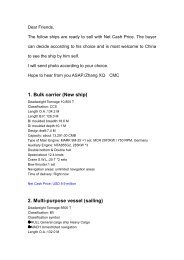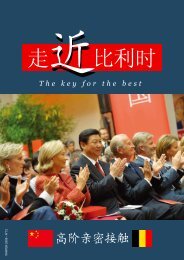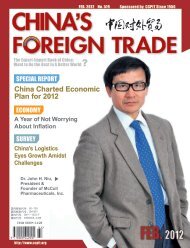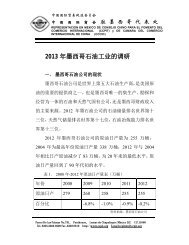F REIGN TRADE - 中国国际贸易促进委员会
F REIGN TRADE - 中国国际贸易促进委员会
F REIGN TRADE - 中国国际贸易促进委员会
You also want an ePaper? Increase the reach of your titles
YUMPU automatically turns print PDFs into web optimized ePapers that Google loves.
Industrial WatchHEALTHIndustrial WatchTaintedSpirulina InvestigationChina is stirred with spirulinainvestigation by governmentand media. Early this year,many doubts rose from mediaand public on spirulina products in themarket, concerning if these productscontained lead, arsenic, and mercury.The concerns were directed at some veryfamous brands in China, such as Byhealthand Green A.State Food and Drug Administration(SFDA) conducted a special investigationinto the spirulina products inFebruary, and released its official reporton its website on March 30. This reportclaimed that they investigated 13 brandsof spirulina products, and three of themare fake products (from Conice, Onice,and Hongyangshen), and one productfrom Cont-healthy had high-levels ofheavy metals. Among them, Coniceand Cont-healthy were advertised as USbrands, and Onice from Australia.The other spirulina products includingthose from Green A, By-health, Jinaoli,Chenghai Lake, Green Classic, B&H,Shengaolikang, Gaozhi, and Shiruian,were claimed to be within national limit, i.e.2.0mg lead in 1kg of product, which wassaid to be the standard for health productsmainly based on algae.However, that was not what themedia expected to see. On February 29, itwas reported in an internal SFDA noticeto state and provincial levels that all thenamed 13 products failed to meet China’sstandards and thus were classified asadulterated. However, when SFDA releasedits final report on March 30, manywere shocked to see that nine of the companiesthat failed were now considered upto standards. This followed by rumors ofcorruption and finger pointing.Many speculated that prior toMarch 30, these nine companies mostlikely visited SFDA, and persuadedthem to revise their findings. Somedoubted that the independent testingBy Alice Yangcenter was fair and objective in conductingtheir tests and that SFDA played toomuch of an influencing factor. Everyonequestioned why the final results landedwhere they did.The Economy Reference, a localnewspaper within Xinhua national newsagency group, also reported that onMarch 5, another notice inside SFDAsystem on fish oil products stated thateight products were disqualified, howeverwhen it was officially released on itswebsite on March 30, there were onlythree left and all of them were titled asfake products. They were Ruideli fishoil capsule, Amway fish oil capsule, andOlilailuomai fish oil soft capsule. TheEconomy Reference asked, “Where arethe results for the rest of products?”The national standard regulationthat should be followed is the GeneralStandards for Health/Function Food,issued by the former State Bureau ofTechnical Supervision in 1997. It says,for general products, the lead limitshould below 0.5mg/kg; for general capsules,1.5 mg/kg; for the drink powderand capsules based on algae, 2.0mg/kg.“How about the spirulina tablet?”The Beijing News asked in its report. Thereis no clear standard for the tablet so far.“If we use 0.5mg/kg as the national limit,Green A and Jinaoli spirulina tablets weretested to contain 0.9mg/kg lead, which is80% over the standard, By-health whichcontains 1.0mg/kg exceeds the standardfor 100%,” the report explained.SFDA can hardly keep silent in thiswave of media probing. On April 10, theyreleased a statement in reference to theresults of the spirulina products they madedays ago, arguing that the 2.0mg/kg aslead maximum limits for spirulinatablets was approved by manyindustrial experts, who view thetablet as the same dose as drinkpowder. They also quoted that theEU uses 3.0mg/kg as the standardfor their dietary supplements.“But, just one month ago,officials from SFDA told reportersthat they used 0.5mg/kg as thestandard,” the Economy Reference saidin its report, which also pointed out thatmany spirulina manufacturers and someprovincial food and drug administrationdepartments understood they should befollowing the 0.5mg/kg standard.Tong Min, Director of HealthProduct and Cosmetics Department ofSFDA, said in an interview with TheEconomy Reference that, “Once a problemcomes, the first responsible personis the enterprise itself, the second, localsupervision department, and the thirdis SFDA.” Another anonymous industrialperson remarked in the report that,“SFDA can easily push aside its responsibilityto local level, or they can fudge theresults of reports which can put-off its supervisionresponsibility and at same timeensure the involved enterprise no-harm.”The report questioned that “If allthe steps and power, including regulationestablishment, administrative licensing,approval, market supervision, testing,penalty and sanction, are all in SFDA’shand, how can there be transparencyand efficient regulation in China?”Wang Lianglan, the spokespersonof SFDA stated on April 11 that SFDAwould study the related report from mediaand promised to be more open andtransparent in the future work.However, the public credibilityof SFDA has already been questioned.Some discussion on the internet asked athird testing party to redo the investigationand release an authorized report toget to the bottom of the situation.42



